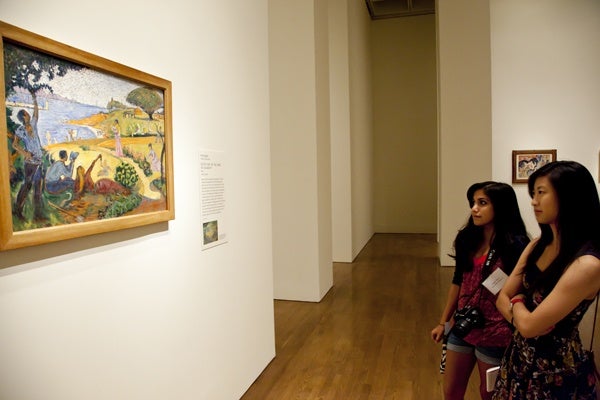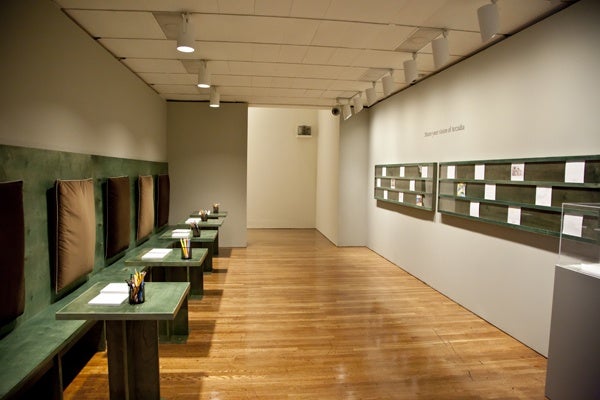‘Visions of Arcadia’ entice at Art Museum
Philadelphia is approaching its limit of Impressionist art.
Just after the Barnes Foundation opened its massive collection of Impressionist paintings on the Parkway, this week the Philadelphia Museum of Art opens “Gauguin, Cezanne, Matisse: Visions of Arcadia.”
Arcadia is a mythical place of pastoral beauty, simple lifestyle, and sensual pleasure. Populated by satyrs and fauns, nymphs and naiads, Arcadia, according to the ancient Greeks, was the birthplace of music and poetry.
The audio tour available at the Philadelphia Museum of Art allows visitors to don headphones and listen to “Prelude to ‘The Afternoon of a Faun'” while looking at those nymphs, satyrs, and naked revelers in repose on riverbanks.
Debussy’s languid woodwinds find purchase in Virgil, whose Eclogues are used as prelude to the exhibition:
Wooing the woodland muse on a slender reed,But we are leaving our country’s bounds and sweet fields.We are outcasts from our country.
As nice and easy (and, yes, naughty) time as Arcadia promises, Virgil hints a darker side. The fictional utopia — a place in mind more than geography — is cut off from time, divorced from the rhythms of the rest of the world. The ancient poet grew up in the bucolic Italian countryside of Mantua, where his father was forced off his own farmland by a king in retreat.
“He was always very wary of notions of idyllic-ness, control,” said curator Joseph Rishel. “Arcadia has a rough side and a smooth side. It is entrapment in certain ways. They can be very nasty about love affairs. There are tears.”
A gathering of bathers
Rishel began his quest for Arcadia with a simple desire. He wanted to see Paul Cezanne’s monumental “The Large Bathers” (owned by the PMA) next to Henri Matisse’s equally monumental “Bathers by a River” (residing at the Art Institute of Chicago). The similar subjects are treated radically differently, but continuities are apparent.
The game was afoot. Paul Gauguin came on board with his Tahitian “Where Do We Come From? What Are We? Where Are We Going? (D’ou venons-nous? Que sommes-nous? Ou allons nouse?)” Then Henri Rousseau’s “The Dream” chimed in, with its hallucinatory image of a nude on a chaise lounge in a jungle.
The game of connect-the-influence expanded to include 41 paintings by 27 artists, some from the PMA’s collection, most borrowed from outside museums and collections.
It could have gone on forever. The image of the utopian nude runs throughout the history of Western art with incredible resilience. Even while early 20th century Impressionist artists such as Cezanne and Matisse were kicking at the foundations of tradition, they still subscribed to the well-worn ideal of a bucolic Arcadia.
“What do you most likely take as your subject to lend authority and credibility to you, as a major artist who should be hanging in the Louvre?” said Rishel. “You are going back to subjects of people standing around, with their clothes off, under trees.”
The exhibition tracks the vision of utopia from the idealized 19th century landscapes of Jean-Baptiste Corot and Pierre Puvis de Chavannes, to the tumultuous modernity of the early 20th century, with the rise of industry, cities, and radical art movements such as cubism.
The city beckons
Robert Delaunay’s huge “The City of Paris” features the Three Graces (nude, of course) rendered in the complex fan-dance of angular cubist pattern, set amid the bustle of 1910 Paris, the Eiffel Tower and towering apartment buildings.
The pastoral ideal of Arcadia moved downtown.
“It’s Audrey Hepburn shopping at Tiffany’s, you know. Having a martini down the street,” said Rishel. “It’s gaiety and chic-ness. That’s the utopian thing, that the modern city will become the idyllic golden city, the New Jerusalem.”
As with all ideals, Arcadia is much nicer in mind than in asphalt. The fragility of the vision is part of its appeal. The poet Stephane Mallarme, whose “The Afternoon of a Faun” is also in the exhibition, writes of alluring nymphs “heavy with tufted slumbers. Was it a dream I loved?”
“Visions of Arcadia” suggests the dream, however precious, survives.
WHYY is your source for fact-based, in-depth journalism and information. As a nonprofit organization, we rely on financial support from readers like you. Please give today.










